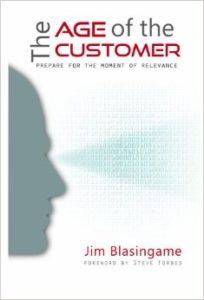
A review of The Age of the Customer: Prepare for the Moment of Relevance by Jim Blasingame, (Florence, AL: SBN Books, 2014).
A good book is one that provokes good questions in the mind of the reader. It need not provide all the answers. The important thing is to challenge the person to think about things differently. This is how one feels upon reading The Age of the Customer: Prepare for the Moment of Relevance by columnist and author Jim Blasingame.
The author has long been an observer, consultant and talk show host who deals with the business world, and especially the small business world. That is why his insights are helpful in making sense out of today’s constantly changing business climate.
Like most business books, this work announces a major paradigm shift. However, contrary to so many business authors, Blasingame’s explanation of what has shifted is both logical and persuasive, not trendy and sensational. The central thesis of his book is that the main focus of business has shifted from the Age of the Seller to the Age of the Customer. Business must now provide not only service but what he calls a “Moment of Relevance” by always being agile and accessible. Certain powerful tools now in the hand of consumers give them the means to determine and control the nature and time of the sale.
Of course, most of these tools come from technological changes that have disrupted markets over the last quarter century. The internet and online commerce have changed many of the rules. Blasingame tells readers how to stay in the game. He even provides an appendix with a collection of his business laws that include, “Never ask a Customer to use your technology unless it’s fall-off-a-log easy.”
Those who expect to find cheap little tips on how to trick the new system will be disappointed. The author states that, “One of the constant themes throughout this book is how much the world has changed and yet how little humans have changed.”
Technology and innovations may have created new expectations, practices and techniques. However, the values, ethics, integrity and authenticity of the entrepreneur must remain unchanged. Indeed, they are more important than ever.
[like url=https://www.facebook.com/ReturnToOrder.org]
The Industrial Revolution ushered in an era in which the seller reigned supreme. The emergence of a mass society with mass market and media tended to suppress the human element in favor of efficiency and economy of scale. The new paradigm brings back some of these suppressed organic elements.
Thus, Blasingame discusses, for example, the new importance of word of mouth marketing that goes “on steroids” with user-generated content that allows consumers to review products online. He insists that the old use of static demographic data in marketing is being trumped by the need to form dynamic buyer communities.
What Does Saint Thomas Say About Immigration?
Storytelling in marketing will assume greater importance as people look beyond the product to connect with values associated with it. Despite all the new gadgetry and apps, face-to-face is the original social media and is still the most powerful, tried-and-true delivery method out there. In the final analysis, Blasingame affirms what everyone should know and ignores to their peril—the fact that, “The primordial human need to connect with others remains, whether physically or virtually.”
However, it is primarily perceived values that will determine success in the new markets. The tools in the hands of the customer make it easier to perceive and reward values, relevance and authenticity. Blasingame notes that “Marketing is what you say; values are what you do – especially when no one is watching.” For the dishonest, the bad news is that more people are now watching. The good news is that the small business owners are uniquely positioned to profit from the new technology by capitalizing on the human values still connected to their personal hands-on management styles.
Among the never-changing practices of business, the author mentions two of the most effective and powerful words out there: “Thank you.” Perhaps that is a fitting way to sum up the book by directing a heartfelt expression of gratitude. Thank you Jim Blasingame for the insights!


